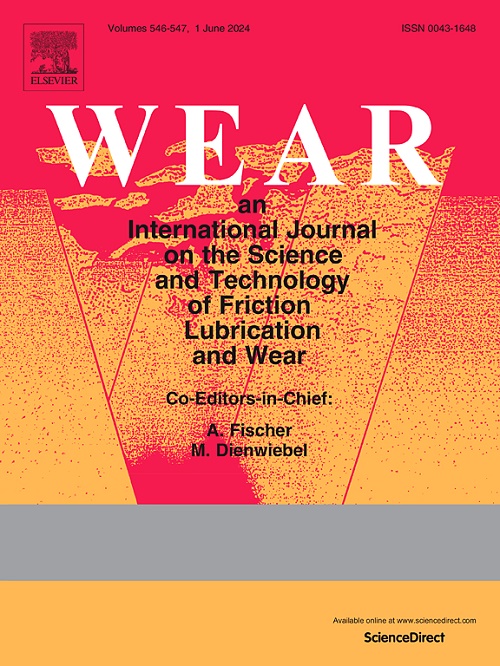3D digital holography for measuring particle impact crater morphology and in-situ analysis of oxidation healing on steel surfaces
IF 5.3
1区 工程技术
Q1 ENGINEERING, MECHANICAL
引用次数: 0
Abstract
Deformation and erosion of steel due to particle impacts in high-temperature environments are common issues in industrial applications. Under high-temperature conditions, an oxide layer forms that affects the deformation and erosion of the steel surface following particle impacts. Studying the interaction mechanism of oxidation and deformation (erosion) is of considerable significance. Traditional research methods primarily involve ex-situ measurements on samples post-erosion and oxidation, which cannot capture the morphological changes of the steel surface immediately following particle impact. Utilizing 3D digital holography (DH) technology, this paper develops a measurement system to investigate the surface morphological changes in steel induced by single particle impacts. We utilized this experimental system to measure the impact crater morphology of 500 μm zirconia particles impacting Q690 steel sheets. Our findings indicate that Hertzian ring cracks formation is significantly affected by heating temperature and impact angle. Notably, oxide layer peeling and erosion occurred at an impact angle of 30°. Additionally, impact crater depths at a 90° angle and impact speeds ranging from 1 to 20 m/s varied between 0.66 and 4.25 μm, with crater depths showing a correlation to the thickness of the oxide layer. Concurrently, in-situ measurements of the impact crater healing process during heating revealed that the crater formed at a 30° impact angle, which had numerous microcracks, exhibited significantly better healing compared to the crater formed at a 90° impact angle. The thickening process of the oxide layer were also analyzed, leading to the derivation of the oxide layer growth kinetic equation based on the measurement data: . This study is the first to use DH technology to measure the surface morphology of steel and to conduct in-situ analysis of the oxide layer thickening process following particle impact and during heating. This approach provides a novel perspective for understanding the erosion-oxidation interaction mechanism.
三维数字全息技术用于测量颗粒撞击坑形态和钢表面氧化愈合的原位分析
在高温环境中,颗粒撞击导致的钢材变形和侵蚀是工业应用中的常见问题。在高温条件下,氧化层的形成会影响颗粒撞击后钢材表面的变形和侵蚀。研究氧化和变形(侵蚀)的相互作用机理意义重大。传统的研究方法主要是对侵蚀和氧化后的样品进行原位测量,无法捕捉到颗粒撞击后钢铁表面立即发生的形态变化。本文利用三维数字全息(DH)技术开发了一套测量系统,用于研究单颗粒撞击引起的钢表面形态变化。我们利用该实验系统测量了 500 μm 氧化锆颗粒撞击 Q690 钢板后的撞击坑形态。我们的研究结果表明,赫兹环裂纹的形成受到加热温度和撞击角度的显著影响。值得注意的是,氧化层的剥离和侵蚀发生在冲击角为 30°时。此外,在 90° 角和 1 至 20 m/s 的撞击速度下,撞击坑深度在 0.66 至 4.25 μm 之间变化,坑深度与氧化层厚度相关。同时,对加热过程中的撞击坑愈合过程进行的现场测量显示,与 90° 撞击角形成的撞击坑相比,30° 撞击角形成的撞击坑具有大量微裂纹,其愈合效果明显更好。此外,还分析了氧化层的增厚过程,并根据测量数据推导出氧化层生长动力学方程:Kp0=2.39×10−8exp(−17401/RT).该研究首次使用 DH 技术测量钢的表面形貌,并对颗粒撞击后和加热过程中氧化层的增厚过程进行原位分析。这种方法为理解侵蚀-氧化相互作用机制提供了一个新的视角。
本文章由计算机程序翻译,如有差异,请以英文原文为准。
求助全文
约1分钟内获得全文
求助全文
来源期刊

Wear
工程技术-材料科学:综合
CiteScore
8.80
自引率
8.00%
发文量
280
审稿时长
47 days
期刊介绍:
Wear journal is dedicated to the advancement of basic and applied knowledge concerning the nature of wear of materials. Broadly, topics of interest range from development of fundamental understanding of the mechanisms of wear to innovative solutions to practical engineering problems. Authors of experimental studies are expected to comment on the repeatability of the data, and whenever possible, conduct multiple measurements under similar testing conditions. Further, Wear embraces the highest standards of professional ethics, and the detection of matching content, either in written or graphical form, from other publications by the current authors or by others, may result in rejection.
 求助内容:
求助内容: 应助结果提醒方式:
应助结果提醒方式:


